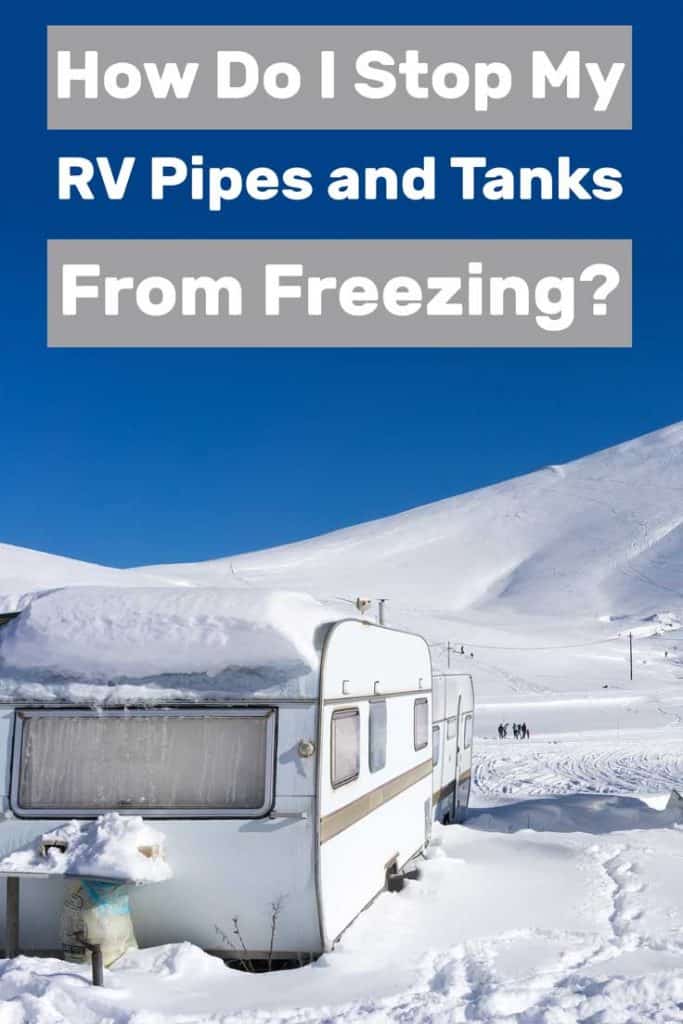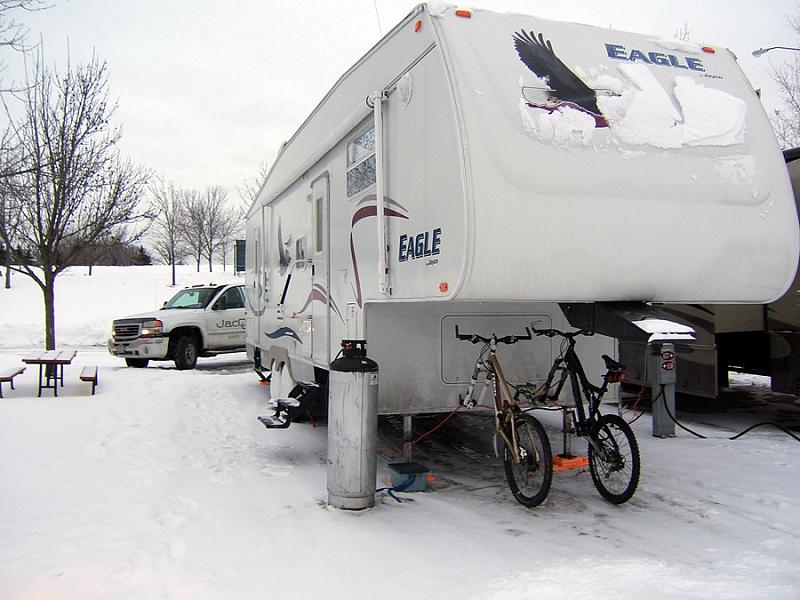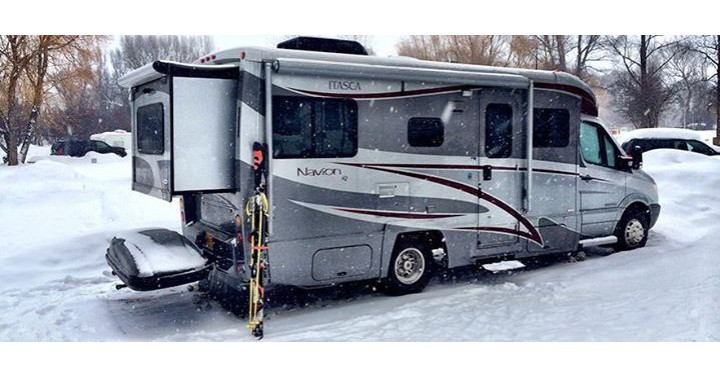The first time you stay in an RV in colder weather, you quickly realize that RVs are not as well insulated as sticks-and-bricks buildings. RV plumbing, which includes pipes, fresh water tanks, and waste tanks, are at high risk for freezing and cracking when it gets too cold. How do you prevent this? As an RV owner who sometimes travels in freezing temperatures, I researched this subject thoroughly.
 There are several things you can do to prevent freezing damage to RV tanks and pipes:
There are several things you can do to prevent freezing damage to RV tanks and pipes:
- Insulating and warming any pipes or tanks that are located outside the RV's interior.
- Keeping the temperature inside the RV above freezing.
- Emptying tanks frequently so that they don't get too full.
- Protecting the connections between your RV and the park's utilities.
How do you go about these? Let's talk about the finer points of these proven strategies for minimizing damage to your RV when temperatures drop.
Keep the temperature inside the RV above freezing
You'll want to do this anyway when you're staying in an RV, but sometimes people turn off their furnaces overnight. If the temperature drops too low, it can quickly become frigid inside the rig.
Although pipes are shown to freeze at 20 degrees Fahrenheit, keep your furnace on your thermostat set to at least 45 degrees overnight to ensure the interior never gets into the freezing temperatures. Also, keep sink cabinet doors open to circulate warm air around the pipes.
When you open the doors, you may notice gaps around the hole where the pipe exits to the wall or floor. Fill those in with a sealant--it will also prevent bugs and rodents from entering your RV.
To keep warm air from escaping, insulate windows and doorways with a product like Reflectix or insulating curtains. Reflectix can also be helpful when placed inside cabinets against the exterior wall, with a small air gap between the wall and the Reflectix.
Remember that when running a propane furnace, you need ventilation. Keep a window or ceiling vent cracked so toxic fumes can escape. Space heaters can also work well to keep your home on wheels warm. Just bear in mind that some parks charge extra for using them. They also consume large amounts of energy, so be careful not to overload your circuits.

Insulate pipes and tanks on the outside of the RV
Some RV models have insulated basement storage areas, with heat ducted to these areas. This is very helpful to keep pipes from freezing if they run through storage bays. If your RV doesn't have this feature, then you will need to take other measures to protect these pipes.
One possibility is to wrap the pipes with insulation. You can do the same with exposed tanks, by applying layers of insulation to their exteriors and then holding the insulation in place with rubberized sheeting. As with the interior on your unit, applying additional insulation to the bays can help contain warmth.
If you're staying in one place for a long time, you might want to invest in skirting around the RV. This will help insulate the underbelly of the rig, but will probably not be enough on its own for very low temperatures.
Warm pipes and tanks on the outside of the RV

A tank heating pad is a low-maintenance option for keeping your tanks from freezing. These pads often have thermostats, so they will automatically turn on when your tank's temperature gets too low and shut off when the tank is warm enough. They can run off your RV's batteries while you're traveling, and shore power when you're plugged in.
Another option is placing small heaters or heat lamps inside the bays to warm the pipes. Just be mindful only of using products that are safe for use in close quarters, and keep any stored items away from the heating units. Other RVers I know use heat tape wrapped around insulation to protect pipes running through storage bays. Be sure to never apply heat tape directly to pipes, as plastic RV plumbing can burn or melt from a direct application.
Empty tanks frequently so they don't get too full
If there's a power outage in your area, a frozen tank may become unavoidable. So in the case of freezing temperatures, let's review some precautions. As you may know, water expands when it freezes. If your holding tank is full or nearly full, the added pressure of freezing can cause it to crack.
Even if a tank doesn't crack, it will likely thaw out near the top first, which is closest to your interior toilet, shower, or sink drain. The thawing liquid might get pushed back up the pipes and into your RV, causing flooding of wastewater. Try to empty your waste tanks when they are only half-full to prevent this issue.
Some parks will tell you to keep your waste valves partially open during freezing weather. But this is a bad idea for the same reason: water that freezes in your drain pipe can push volume back into your RV. It's also never a good idea to keep both your black and grey tanks open at the same time because you don't want black water contaminating your grey tank. So keep that black tank closed.
As for your fresh water tank, it's best to keep it empty. If you don't have access to a water hookup, keep your fresh water tank no more than half full.
Protect connections between your RV and the park's utilities
Fluids in hoses between the RV and campground utilities especially susceptible to freezing. It's essential to maintain a downward slope from your RV's sewer connection to the drain. This is accomplished with sewer hose supports of varied heights. Some people also switch from the standard RV sewer hose to solid PVC pipes prevents cracking and leaking; solid pipes can also be angled toward the drain with fewer points of support.
Most campgrounds located in climates that dip below freezing have insulated water spigots. But once the water leaves the tap and enters your hose, it still needs protection, because the hose will sit on the cold ground with water inside until you open a faucet.
You can buy a heated fresh water hose through most RV supply locations. You can also make your own by covering a regular fresh water hose with insulation and then applying heat tape to the exterior of the insulation. In milder climates, I've found that wrapping the hose with a non-LED rope light generated enough warmth to keep the hose safe down to as low as 25 degrees Fahrenheit.
You can also keep one tap dripping, such as your kitchen faucet, to prevent stagnant water from becoming too icy inside your fresh hose.

What to do if your RV plumbing freezes
If you find yourself without running water, it's likely you have frozen pipes and possibly tanks. There are some immediate steps you can take to reverse the freezing and hopefully prevent damage. When pipes thaw, there will be a burst of water, so it's best to keep the faucets turned on to a trickle while you're working on them.
First, try to determine where the freezing occurred. You will want to make sure that lines going to and from the utility connections are clear. Since one of the most damaging things that can happen is burst wastewater tanks, you'll want to address that first.
Go outside and check your sewer hose. If it feels frozen at all, thaw it starting at the sewer drain and moving back toward your RV's sewer outlet. Use heat tape or a hair dryer and run it along the length of the hose until the water drains out. If you suspect your holding tanks are frozen, place space heaters below them to warm them up.
Next, move on to check your fresh water hose first to see if it froze. If it did, turn off the spigot and disconnect it from your RV. You can use the same tools as you did for the sewer hose to defrost the water inside. After working on the fresh water hose, you can also open your utility bay and point a heater or hair dryer at the connection.
Now it's time to check inside. With your hoses re-connected, check each water source, one at a time, to see if any of them work. This will help you focus on which pipes need warming on the exterior of the rig. You should also open up all cabinet doors and turn your furnace up.
It's best not to flush your pipes with hot water, because the temperature difference can cause them to crack. Patience and close monitoring are your best bets in this scenario.
While you're waiting for the pipes to thaw, stay with your RV and keep an eye on the situation. Check on your toilet and shower as well for melting water backups.
Once you have running water to all faucets and the toilet, check both the interior and exterior for any leaks. If you find any drips or cracking, drain your tanks and immediately shut off all water to the rig and have leaks repaired before they get worse.
There are many tools you can use to prevent your RV pipes and tanks from freezing. The best solutions are a combination of many different things rather than using only one item. Having these items on hand in case of freezing weather and watching the forecast are the two best preventive measures you can use. Once that cold front approaches, put your tools to use!

Thank you for providing this information; it will be really useful to me. Consider how inconvenient it would be to be on vacation somewhere lovely and have a clogged RV sewer due to a frozen hose. The enjoyment would undoubtedly come to an end, and you’d be scrambling for a fix. This is why, if you’re traveling in cold weather, you should know how to protect your RV sewer pipe from freezing.